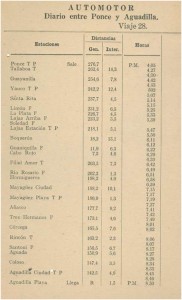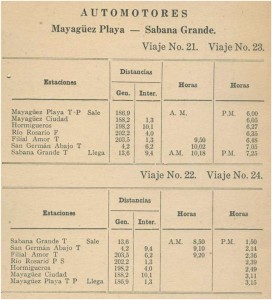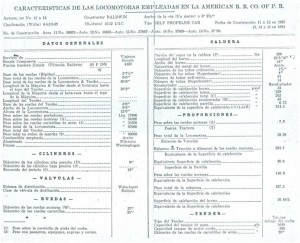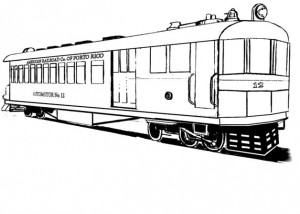
 Los trenes de pasajeros de la American Railroad consistían de una locomotora, un vagón de equipaje, y varios vagones de pasajeros. Para economizar en costos y dar un mejor servicio de pasajeros que compitiera con las guaguas y carros, se recurrió a los automotores de vapor. Estos tenían integrados en una sola unidad, la locomotora y los vagones de equipaje y pasajeros.
Los trenes de pasajeros de la American Railroad consistían de una locomotora, un vagón de equipaje, y varios vagones de pasajeros. Para economizar en costos y dar un mejor servicio de pasajeros que compitiera con las guaguas y carros, se recurrió a los automotores de vapor. Estos tenían integrados en una sola unidad, la locomotora y los vagones de equipaje y pasajeros.
Podían remolcar (arrastrar) un vagón de pasajeros. El automotor tenía capacidad para 46 pasajeros y llevaba equipaje, correo, y paquetes. El vagón de arrastre tenía capacidad para 50 pasajeros.
The passenger trains operated by the American Railroad consisted of a steam engine, a baggage car, and various passenger cars. In order to economize in costs and give a better service to passengers and compete with buses and cars, the company turned to steam operated motor cars or self propelled cars (railcar). These railcars integrated the steam locomotive, baggage and passenger car in one unit.
The motor car could pull a car. The capacity was 46 passenger and it carried luggage, mail, and parcels. The trailer had a capacity of 50 passengers.
See/Ver: Baldwin Locomotives (magazine) , Vol. 3 No. 2, October 1924, pp.54-59, R. Carrion. “The American Railroad Company of Porto Rico”.
Itinerarios de los Automotores / Motor Car Train Schedules


 Source / fuente: American Railroad Company of Porto Rico, Manual de Explotación, 1926.
Source / fuente: American Railroad Company of Porto Rico, Manual de Explotación, 1926.
Motor Car (Self propelled car) Characteristics
 Source / Fuente: American Railroad Company of Porto Rico, Manual de Explotación, 1926
Source / Fuente: American Railroad Company of Porto Rico, Manual de Explotación, 1926
Sources / Referencias – “Steam Motor Cars for a Porto Rican Railroad”, Railway Age, March 21, 1925, pages 793 – 794; American Railroad Company of Porto Rico, Manual de Explotación, 1926; The Locomotives that Baldwin built, containing a complete facsimile of the original History of the Baldwin Locomotives Works, 1831 – 1923 – 1966, by Fred Westing.
I am very grateful to Rob Dickinson :
http://www.internationalsteam.co.uk/internat.htm
http://www.internationalsteam.co.uk/dvd/isvideos.htm
http://www.internationalsteam.co.uk/mills/livesteam.htm
Mr. Dickinson referred me to Christoper Walker, publisher of Trackside Publications, which specializes in Latin American Railroads. Some of the books published: Railways of Peru, Vols. I and 2, by Robert D. Whetham; The Nitrate Railways (Chile) by Donald Binns; Railways of Latin America in Historic Postcards, Narrow Gauge in Colombia – Railways & Steam Locomotives and Narrow Gauge Railways of Cuba – From the 1860s to the present day, both books by Christopher Walker.
Le estoy agradecido al Sr. Dickinson por referirme a Christopher Walker, publicador de Trackside Publications, la cual se especializa en libros de ferrocarriles de America Latina.
El automotor de vapor / The steam powered passenger car
TRAIN SHED CYCLOPEDIA No. 20 by Newton Gregg

 Side view of front truck. (Baldwin Locomotive Works) / Ruedas de la parte del frent del automotor
Side view of front truck. (Baldwin Locomotive Works) / Ruedas de la parte del frent del automotor
I am grateful to Mr. Sam Berliner, III for these photos and to Karen Stephans, Stephans Railroad History, of Talbott, Tennessee. Please visit Mr. Berliner’s extensive and interesting web site at http://sbiii.com/boxcabs4.html (11 June 2012).
TRAIN SHED CYCLOPEDIA No. 20 by Newton Gregg. The TRAIN SHED series is copyrighted by Karen Stephans, owner of Stephans Railroad History of Talbott, Tennessee, a dealer in RR books, effective 09 July 2004 (or earlier). See: http://sbiii.com/boxcabs4.html (11 June 2012). and link to http://railroadtreasures.com/ . (January 13, 2010)
 Dibujo / Drawing: José Ramón López Guadalupe, Ponce, P.R., 2009.
Dibujo / Drawing: José Ramón López Guadalupe, Ponce, P.R., 2009.
A simple activity for school children is the drawing of trains from photos.
Una actividad para estudiantes de escuela es el dibujo de los ferrocarriles de Puerto Rico usando como referencia fotos. Como proyecto de grupo ¿Podrán hacer un libro de pintar de los ferrocarriles de Puerto Rico?
© 2009 Roger W. Aponte
